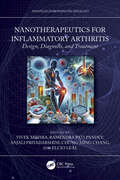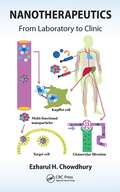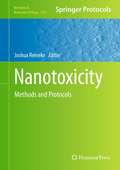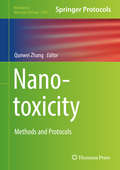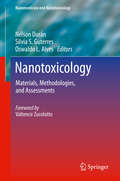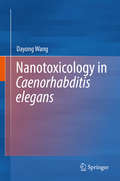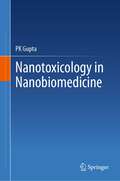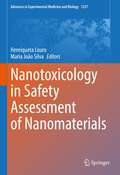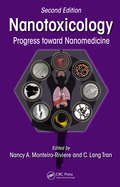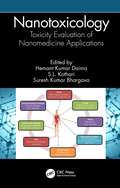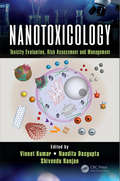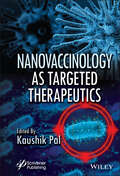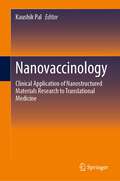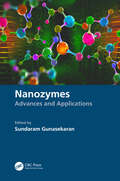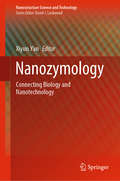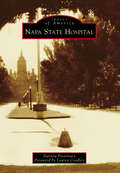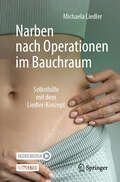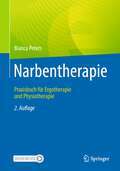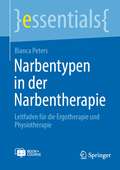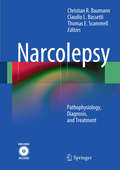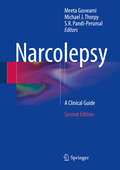- Table View
- List View
Nanotherapeutics for Inflammatory Arthritis: Design, Diagnosis, and Treatment (Advances in Bionanotechnology)
by Vivek Mishra Anjali Priyadarshini Ramendra Pati Pandey Chung-Ming Chang Elcio LealNanotherapeutics for Inflammatory Arthritis: Design, Diagnosis, and Treatment highlights nanobiotechnology and its therapeutic applications in the field of inflammatory arthritis, the interaction of nanomaterials in the biological systems, and clinical development of nanomedicines. It also covers the discovery of personalized therapeutics, diagnostics, and nanoparticular delivery systems, the role of bioinformatics nanobiotechnology in personalized oncology. The use of nanosensors for the detection and current challenges in the development of personalized medicine is explained including recent nanotechnology-based strategies.Features: Covers all the fundamental information about nanotechnology and inflammatory arthritis. Highlights the interaction of nanomaterials in the biological systems, and the clinical development of nanomedicines for inflammatory arthritis. Explores the discovery of personalized therapeutics, diagnostics, and nanoparticle delivery systems. Reviews the current challenges in the development of personalized medicine as well as translation of nanomedicine with combination therapy. Discusses the toxicology of using nanomedicines and the risks associated with the use of these nanomedicines. This book is aimed at researchers and professionals in nanotechnology, biomaterial, drug delivery, and inflammatory arthritis.
Nanotherapeutics: From Laboratory to Clinic
by Ezharul Hoque ChowdhuryThe emergence of nanotherapeutics is attributable to the integration of nanotechnology, recombinant DNA technology, and synthetic organic chemistry with medicine for treating critical human diseases in a more efficient and specific molecular approach than therapy with conventionally-designed and formulated drugs. Nanotherapeutics: From Laboratory t
Nanotherapy for Brain Tumor Drug Delivery (Neuromethods #163)
by Vivek Agrahari Anthony Kim Vibhuti AgrahariThis volume provides a guide on nanoformulations and other drug delivery approaches for both academic and industry scientists. The chapters in this book cover diverse topics and techniques in nanoparticle drug delivery, gene therapy, neurosurgical brain implant, exosomes, MRI-guided focused ultrasound (MRgFUS), and advanced preclinical glioblastoma multiforme animal models. Some chapters discuss state-of-the-art and innovative nanomedicines for glioblastoma, surface-modified nanoparticle drug carriers for brain cancer treatment, focused ultrasound (FUS)-mediated blood-brain barrier disruption for enhanced drug delivery to brain tumors; gene therapy delivery approaches to treat brain cancer, and a liposome-template hydrogel nanoparticles (LHNPs) as a powerful CRISPR/Cas9 delivery vehicle. In the Neuromethods series style, chapters include the kind of detail and key advice from the specialists needed to get successful results in your laboratory. Cutting-edge and thorough, Nanotherapy for Brain Tumor Drug Delivery is a valuable resource for the scientific community working on this important therapeutic field, and will help fast-track the clinical translation of revolutionary nanotechnologies for treating brain tumors.
Nanotoxicity
by Joshua ReinekeThe field of nanotechnology has developed very rapidly over the past decade lending great promise to medical applications in drug delivery, therapeutics, and biological imaging. Due to the great promise, rapid development, and broad application of nanomaterials, it is imperative that researchers from development through application seek a thorough understanding of nanotoxicity. Nanotoxicity: Methods and Protocols address the special considerations when applying toxicity studies to nanomaterials and detail newly developed methods for the study of nanotoxicity. These diverse methods span in vitro cell culture, model tissues, in situ exposure, in vivo models, analysis in plants, and mathematical modeling, proving to be relevant to pharmaceutical scientists, material scientists, bioengineers, toxicologists, environmentalists, immunologists, and cellular and molecular biologists, to name a few. As part of the highly successful Methods in Molecular BiologyTM, chapters include introductions to their respective topics, lists of the necessary materials and reagents, step-by-step, readily reproducible laboratory protocols, and tips on troubleshooting and avoiding known pitfalls. Comprehensive and cutting-edge, Nanotoxicity: Methods and Protocols aims to diversify the capabilities of current researchers involved in nanotoxicology and to enable researchers in related fields to expand their knowledge of how nanomaterials interface with the biological environment.
Nanotoxicity: Methods And Protocols (Methods in Molecular Biology #1894)
by Qunwei ZhangThis volume explores the latest techniques used to investigate nanotoxicity. The protocols covered in this book range from routine nanotoxicity assays to genomic and proteomic approaches in vivo and in vitro. The chapters discuss specific topics such as preparation and utilization of 3D human liver microtissue models; assessment of ovarian granulosa cells with exposure to nanoparticles; DNA methylation analysis; evaluation of genotoxicity of nanoparticles in mouse models; and studying nanotoxicity using embryonic zebrafish. Written in the highly successful Methods in Molecular Biology series format, chapters include introductions to their respective topics, lists of the necessary materials and reagents, step-by-step, readily reproducible laboratory protocols, and tips on troubleshooting and avoiding known pitfalls.Cutting-edge and practical, Nanotoxicity: Methods and Protocols is a valuable resource for researchers and postgraduate students in the fields of toxicology, environmental science, pharmacological sciences, and clinical medicine. This volume also serves as a starting point for researchers interested in learning more about this developing field.
Nanotoxicology
by Nelson Durán Silvia S. Guterres Oswaldo L. AlvesThis book takes a systematic approach to nanotoxicology and the developing risk factors associated with nanosized particles during manufacture and use of nanotechnology. Beginning with a detailed introduction to engineered nanostructures, the first part of the book presents concepts and definitions of nanomaterials from quantum dots to graphene to fullerenes, with detailed discussion of functionalization, stability, and medical and biological applications. The second part critically examines methodologies used to assess cytotoxicity and genotoxicity. Coverage includes interactions with blood (erythrocytes), combinatorial and microarray techniques, cellular mechanisms, and ecotoxicology assessments. Part three describes cases studies both in vitro and in vivo for specific nanomaterials including solid lipid nanoparticles and nanostructured lipid carriers and metallic nanoparticles and metallic oxides. New information is also presented on toxicological aspects of poloxamers and polymeric nanoparticles as drug carriers as well as size effects on cytotoxicity and genotoxicity. Didactic aspects are emphasized in all chapters, making the book suitable for a broad audience ranging from advanced undergraduate and graduate students to researchers in academia and industry. In all, Nanotoxicology: Materials, Methodologies, and Assessments will provide comprehensive insight into biological and environmental interactions with nanostructures. Provides an introduction to nanostructures actually in use Describes cyto- and genotoxicity methodologies, and assesses their performance in comparison to common toxicity assays Discusses the relation of cytotoxicity and genotoxicity to ecotoxicity Presents a range of applications, from biogenic silver nanoparticles to poloxamers as drug-delivery systems, reflecting the expanding applications of nanotechnology
Nanotoxicology in Caenorhabditis elegans
by Dayong WangThis book focuses on the toxicity of engineered nanomaterials (ENMs) and their underlying physicochemical, cellular, physiological, and molecular mechanisms. Further, it covers ENMs’ translocation and their targeted organ toxicology, and discusses chemical and pharmacological strategies used to combat nanotoxicity. Engineered nanomaterials (ENMs) are defined as materials with one or more dimensions of less than 100 nm, and have shown considerable promise in several areas of development. At the same time, the potential toxicity of ENMs for human health and environmental organisms is increasingly attracting attention. In addition to the typical properties of model animals, Caenorhabditis elegans is extremely sensitive to environmental toxicants, which makes it the ideal in vivo assay system for toxicological studies. C. elegans has been widely used in toxicity assessment and toxicological studies of environmental toxicants and stresses. This book provides a comprehensive summary of nanotoxicology research on C. elegans.
Nanotoxicology in Humans and the Environment (Molecular and Integrative Toxicology)
by Jamie R. Lead Shareen H. Doak Martin J. D. CliftThe book covers the area of ‘Nanotoxicology’ but primarily from the point of view of nanotoxicology at the interface with other disciplines including human toxicology; environmental toxicology; characterization, dose and transformations; regulation; public and elite group perceptions; and interactions with innovation.Nanotoxicology in Humans and the Environment is written for researchers in nanotoxicology in academia, industry, government, and research students. Given the rapid development, the maturing of the discipline and its importance in current regulation and industry development (eg REACH, TSCA), the book is very timely.
Nanotoxicology in Nanobiomedicine
by PK GuptaThis book provides that knowledge needed to introduce individuals to the most important research and content on nanotoxicology in nanobiomedicine. Nanotechnology is helping to considerably improve, even revolutionize many technology and industry sectors: information technology, homeland security, medicine, transportation, energy, food safety, and environmental science, among many others. There is an urgent need for a general reference textbook that presents the most recent information on the toxicity and its effects in all these sectors, biomedicine in particular. It includes historical information, nanotoxicology by subject area and or disease, sources of nanomaterials, drug delivery systems and more. Scientists, researchers, and students in all fields that use nanotechnology will find this book essential reading.
Nanotoxicology in Safety Assessment of Nanomaterials (Advances in Experimental Medicine and Biology #1357)
by Henriqueta Louro Maria João SilvaSince its advent, nanotechnologies are considered key enabling technologies that take advantage of a wide array of nanomaterials (NMs) for biomedical and industrial applications generating significant societal and economic benefits. However, such innovation increases human exposure to these substances through inhalation, ingestion or dermal contact raising public health concerns. Furthermore, the NMs’ specific physicochemical properties, that confer them unique beneficial characteristics, can also elicit nano-bio interactions leading to toxicity and concerns for public health. In addition, such properties can be affected by the surrounding matrix, particularly when incorporated in complex matrices such as food products, leading to secondary features potentially more relevant than primary characteristics for determining their toxicological outcome. These nano specific issues raise the question of whether the NMs may produce adverse outcomes that are not accounted for when using conventional toxicological approaches to assess their safety. Such uncertainties about the safety of NMs for human health and the environment may hamper a faster and more widespread exploration of their potentials. In response, the NMs definition has evolved, and nanotoxicology has developed towards new and more integrative approach methods to support regulatory and policy actions. This book provides a perspective on recent developments in the synthesis, application, and characterization of NMs and the related nanotechnologies, focusing on nanotoxicology for their accurate safety assessment early in the product development stage. The use of complex in vitro models, including multicellular systems and organoids, and “omics-based” approaches, such as transcriptomics or epigenomics, have greatly contributed to an in-depth understanding of the cellular and molecular mechanisms behind some NMs toxicity. Such mechanistic knowledge is equally addressed in this book and has set the basis for a predictive nanotoxicology approach building on adverse outcome pathways. In addition, considering the knowledge provided by the above-mentioned approaches, insights into risk assessment, standardization, and regulation of NMs are also included. Incorporating adequate nanosafety assessment early in the life-cycle of NMs will allow the implementation of the safe and sustainable-by-design paradigm enabling safety to keep pace with innovation. Chapters 10 and 15 are available open access under a Creative Commons Attribution 4.0 International License via link.springer.com.
Nanotoxicology: Progress toward Nanomedicine, Second Edition
by Prasen Palvankar Joop Koster C. Lang Tran Nancy A. Monteiro-RiviereSince the first publication of this book in 2007, the field of nanoscience and nanomedicine continues to grow substantially. This second edition, Nanotoxicology: Progress toward Nanomedicine, enlists internationally recognized experts to document the continuing development and rationale for the safe design of engineered nanomaterials (ENM). This in
Nanotoxicology: Toxicity Evaluation of Nanomedicine Applications
by Hemant Kumar Daima S. L. Kothari Suresh Kumar BhargavaThe field of nanomedicine has risen quickly due to the increasing number of designer-made nanomaterials. These nanomaterials have the potential to manage diseases and change the way medicine is currently studied. However, the increased practice of using nanomaterials has shed light on how many concepts of nanomedicine and nanotoxicity have been overlooked. Nanotoxicology: Toxicity Evaluation of Nanomedicine Applications addresses the existing gaps between nanomedicine and nanotoxicity. This book also brings together up-to-date knowledge on advances toward safe-by-design nanomaterials and existing toxicity challenges. This book delivers a comprehensive coverage in the field with fundamental understanding, serving as a platform to convey essential concepts of nanotoxicology and how these concepts can be employed to develop advanced nanomaterials for a range of biomedical applications. This book is an effort to answer some of the thoughtful nanotoxicological complications and their auspicious probable solutions with new approaches and careful toxicity assessment. Key Features: Reveals novel nanoscale approaches, toxicity assessment, and biomedical applications Includes importance of nanotoxicity concepts in developing smart nanomaterials Highlights unique contributions and "A to Z" aspects on the state-of-the-art from global leaders Offers a complete package to learn fundamentals with recommendations on nanomaterials toxicity and safe-by-design nanomedicines Nanotoxicology: Toxicity Evaluation of Nanomedicine Applications illuminates the high potential of many innovative nanomaterials, ultimately demonstrating them to be promising substitutes for available therapies that can be effectively used in fighting a myriad of biomedical complications. Further, this book reports legal, ethical, safety, and regulatory issues associated with nanomaterials, which have often been neglected, if not overlooked in literature and limiting clinical translation at nanoscale level. It will equip readers with cutting-edge knowledge of promising developments in nanomedicine and nanotoxicology, along with potential future prospects.
Nanotoxicology: Toxicity Evaluation, Risk Assessment and Management
by Vineet Kumar, Nandita Dasgupta and Shivendu RanjanAs the application of nanotechnology in the myriad disciplines of science and engineering--from agriculture, pharmaceuticals, material science, and biotechnology to sensors, electronics, and mechanical and electrical engineering--brings benefits it also can produce serious threats to human health and the environment that must be evaluated. The unique properties of nanomaterials make them different from their bulk counterparts. In addition to such unique properties, the nanometric size of nanomaterials can invite some detrimental effects on the health and well-being of living organisms and the environment. Thus, it is important to distinguish nanomaterials with such ill effects from nanomaterials with no or minimum toxicity. Nanotoxicology: Toxicity Evaluation, Risk Assessment and Management covers issues such as the basic principles of nanotoxicity, methods used for nanotoxicity evaluation, risk assessment and its management for nanomaterial toxicity with a focus on current trends, limitations, challenges, and future directions of nanotoxicity evaluation. Various experts from different countries discuss these issues in detail in this book. This will be helpful to researchers, educators, and students who are interested in research opportunities for avoiding the environmental and health hazards of nanomaterials. This book will also be useful for industrial practitioners, policy makers, and other professionals in the fields of toxicology, medicine, pharmacology, food, drugs, and other regulatory sciences.
Nanovaccines: An Innovative Technology to Fight Human and Animal Diseases
by Sergio Rosales-Mendoza Omar González-OrtegaThis book provides a compilation of the current developments in mucosal nanovaccines, which are an attractive approach to fight against infectious and non-communicable diseases. Since nanomaterials possess unique properties; many of them have a positive effect on vaccine efficacy when used as antigen carriers and have been applied in vaccinology with significant advances over the past years. This book addresses the methodologies for mucosal nanovaccines synthesis; based on the following nanomaterials: gold, PLGA, silica, and chitosan nanoparticles; as well as nanogels, carbon nanotubes, liposomes, and Virus-like particles. A description of the immunogenic properties of the mucosal nanovaccines is presented, highlighting the improvements achieved with this approach when compared to conventional formulations. Mucosal vaccines constitute the most practical immunization approach since they are easy to administer (promoting patient´s comfort and increasing compliance), allow triggering relevant immune responses at both the site of administration and distant compartments, and thus may protect the main entry portal for pathogens (oral, nasal, and genital mucosae). In this context, the potential of nanovaccines to result in new mucosal formulations in the benefit of global health is analyzed. Covers the synthesis and functionalization of nanomaterials for the development of nanovaccines;Discusses the underlying mechanisms involved in the induction of immune responses through mucosal compartments and the advantages of nanomaterials in the formulation of nanovaccines;Transmits the state of the art for the development of mucosal nanovaccines;Provides routes for the design and evaluation of mucosal nanovaccines;Presents key perspectives for the field of mucosal vaccine development.
Nanovaccinology as Targeted Therapeutics
by Kaushik PalNANOVACCINOLOGY AS TARGETED THERAPEUTICS The book presents the early-stage development of nanovaccines that could well be the new generation of vaccines which have a great potential for the prevention and treatment of many diseases. Nanovaccinology as Targeted Therapeutics explores recent breakthroughs in the exciting new field of micro- and nanofabricated engineered nanomaterials. In addition to spectroscopic characterizations, significant topics for interdisciplinary research, especially in the fields of nanogels, which deal with polymer chemistry, nanotechnology, materials science, pharmaceuticals, and medicine are explored, where their small dimensions prove highly advantageous. Nanovaccinology could potentially revolutionize conventional therapy and diagnostic methods due to its superior effectiveness over its macro-sized counterparts in almost all biomedical areas. Strong interest in this novel class of material has driven many studies to discover biogenic production methods and new areas of potential utilization in this area. Therefore, it is important to keep abreast of the development of these biomedical research aspects highlighted in the 19 chapters of this book written in diverse fields of studies, and their emerging applications utilized in next-generation techniques. Audience Biotechnologists, nanotechnologists, materials scientists, biochemists, medical biologists, drug delivery and formulation chemists, virologists and pharmacists.
Nanovaccinology: Clinical Application of Nanostructured Materials Research to Translational Medicine
by Kaushik PalThis book provides an overview of the cumulative work on a driving force for innovation in medicine and modern healthcare, boosting advances in therapeutics, biosensors, vaccines, and clinical systems. The work presented shows how nanoparticles have been investigated as vaccine adjuvants because they possess chemical and structural properties that improve immunogenicity as well as the use of nanotechnology in the construction of immunization systems that has developed into the field of viral nanovaccinology. The volume highlights potential areas of research, innovation, and development of finished products for future commercialization and significant research exploration through nanoparticles that prove capable of surmounting most of the barriers like toxicity issues, clearance from biological system, DNA instability, and differences in expression systems. The contributing authors review the primary literature on principles, limitations, and recent breakthroughs in nanoparticle-based antigen delivery vehicles, their use in different diseases, the major bottlenecks, and related issues. Highlighting advances in nanoparticle engineering and the understanding of nanoparticle characteristics as well as critical legacy work dome in the field of nanobiotechnology, the book is ideal for a range of researchers and students in the pure and applied sciences devoted to nanomaterials, vaccinology, and translational medicine.
Nanozymes: Advances and Applications
by Sundaram GunasekaranThis book presents the state-of-the-art advances and applications of nanozymes, the recently developing branch of enzymology that synthesizes and uses nanomaterials that mimic the function of traditional enzymes. During the past decade, the study of nanozymes has grown rapidly. Several new nanomaterials that exhibit enzymatic actions have been identified, along with new applications for their practical use. This book draws upon the work of experts from around the world and provides an in-depth analysis and cutting-edge overview of nanozymes, with an eye toward their present and future applications. Chapters are arranged in a logical order to provide physio-chemical characterization of nanozyme and basic mechanisms of their enzymatic actions. Focusing on current limitations of nanozymes and their reaction kinetics, the book presents a comprehensive discourse on nanozyme engineering that includes possible surface modifications to enhance nanozyme effectiveness. It also focuses on traditional and novel nanozyme applications, such as biosensing, drug delivery, and disease therapy, as well as their use as antibacterials. An important addition in this book is the summary of emerging literature on nanozyme toxicology. This book is intended as a ready reference for advanced undergraduate and graduate students doing research in nanotechnology; materials science; chemistry; and chemical, biological, biomedical, and food engineering. Research and development scientists, engineers, and technologists working in the chemical and biological/biomedical industries will gain much from the materials in this book for their industry practice. Presents a comprehensive discourse on nanozyme engineering that includes possible surface modifications to enhance nanozyme effectiveness. Discusses metal organic frameworks as nanozymes. Reviews on traditional and novel nanozyme applications, such as biosensing, drug delivery, disease therapy, and their use as antibacterials. Examines nanozyme toxicology. Dr. Sundaram Gunasekaran is a Professor in the Department of Biological Systems Engineering at the University of Wisconsin–Madison.
Nanozymology: Connecting Biology and Nanotechnology (Nanostructure Science and Technology)
by Xiyun YanThis book introduces the new concept of “nanozyme”, which refers to nanomaterials with intrinsic enzymatic activity, rather than nanomaterials with biological enzymes incorporated on the surface. The book presents the cutting-edge advances in nanozyme, with emphasis on state-of-the-art applications in many important fields, such as in the biomedical fields and for environmental protection. The nanozyme is a totally new type of artificial enzyme and exhibits huge advantages over natural enzymes, including greater stability, low cost, versatility, simplicity, and suitability for industry. It is of interest to university researchers, R&D engineers, as well as graduate students in nanoscience and technology, and biology wishing to learn the core principles, methods, and the corresponding applications of “nanozyme”.
Napa State Hospital
by Lauren Coodley Patricia PrestinaryNapa, because of its natural beauty and optimal conditions for "moral treatment," was chosen as the second site for a state hospital to ease overcrowding in Stockton Asylum. When the fully self-sustaining Napa Asylum opened in 1875, it quickly filled to capacity and became home to many people suffering from mental illness, alcoholism, grief, and depression. In 1924, Napa Asylum was renamed Napa State Hospital to reflect changes in the medical model and treatments for psychiatric patients. Covering the first 100 years of the hospital's history, this unique book tells the story of the institution and the people for whom it served as employer. Known locally as Imola, this beautiful site became an integral part of the community.
Narben nach Operationen im Bauchraum: Selbsthilfe mit dem Liedler-Konzept
by Michaela LiedlerIn diesem Ratgeber erhalten Sie umfassende Einblicke im Umgang mit Narben bei Beschwerden nach einer Operation im Bauchraum und deren Auswirkungen auf den restlichen Körper. Sie lernen praktische Techniken zur Selbsthilfe, die Ihnen schnell und effektiv Linderung verschaffen. Gleichzeitig erfahren Sie, den Schmerz als eine Art der Kommunikation Ihres Körpers zu verstehen und wie Sie mit akuten und langanhaltenden Schmerzen umgehen können. Aus dem Inhalt: Fachwissen über die Funktionsweise und Funktionsstörungen des Körpers, Verklebungen von Faszien im Gewebe und Verwachsungen im Bauchraum, Indikationen und Kontraindikationen für die Behandlung der Narbe, Eigenübungen für jedes Stadium der Wundheilung, Alltagsbewegungen und Schlafpositionen, Fragen und Antworten aus dem Alltag mit Narben, Plus: Videos mit Übungsanleitungen via Springer Nature More Media-App
Narbentherapie: Praxisbuch für Ergotherapie und Physiotherapie
by Bianca PetersDieses Praxisbuch vermittelt alles Wesentliche für die Behandlung verschiedener Narbentypen in Ergotherapie und Physiotherapie. Wie beeinflusst ein Vitamin A-Mangel die Narbenheilung? Welche Kontraindikationen gibt es für die Narbenmassage parallel zur Narbe? Welche Faktoren können zur Stagnation des Heilungsprozesses führen und wie kann ihnen entgegengewirkt werden? Die Expertin liefert Ihnen die Antworten.Aus dem Inhalt:• Aufbau der Haut, Wundheilung, Ödembildung, Schmerzentwicklung und verschiedene Narbentypen• Befund inklusive Anamnese, Inspektion, Palpation und Funktionsprüfung• Behandlungstechniken mit und ohne Hilfsmitteln, Biofeedback, Thermotherapie und Taping u.v.m.• Hausaufgabenprogramm für Patient*innenPlus: Befundbogen, Narbenprotokoll und Reflexionsbogen zum DownloadNeu in der 2. Auflage: Komplett überarbeitet und aktualisiert; neue Kapitel zum Einfluss von Medikamenten und Hormonen auf die Wundheilung
Narbentypen in der Narbentherapie: Leitfaden für die Ergotherapie und Physiotherapie (essentials)
by Bianca PetersNach einer Operation, einem Gewebstrauma oder auch nach Bestrahlung kann es zu auffälligen Narben mit wulstigem, atrophem oder auch fibrotischem Wachstum kommen. Treten hierbei mittel- bis langfristig Beschwerden bei Patient*innen auf, so sollte die jeweilige Narbe entsprechend behandelt werden. Tiefergehende Kenntnisse über die Hautschichten und Wundheilungsstörungen sind für die zielgerichtete Behandlung hilfreich. Im vorliegenden essential werden wichtige Narbentypen und deren Besonderheiten schrittweise erklärt. Konkrete Vorgehensweisen bei schlecht heilenden, schmerzenden, oder trockenen und juckenden Narben werden besprochen.Den kostenlosen Zugang zum Online-Kurs finden Sie direkt im Buch.
Narcissistic Personality Disorder
by Elsa RonningstamThis volume presents significant recent advances in research and clinical practice in the area of pathological narcissism and narcissistic personality disorder (NPD). Originally published as a Special Supplement to the Journal of Personality Disorders, the book brings together leading clinical experts. Chapters examine the neuroscientific and psychological underpinnings of NPD, describe cutting-edge diagnostic approaches, and explore the complexities of the therapeutic relationship. Addressing the "dos and don'ts" of clinical work with this population, the book reviews the status of specialized treatment strategies--such as transference-focused psychotherapy and mentalization-based treatment--and identifies important directions for future research.
Narcolepsy
by Thomas E. Scammell Claudio L. Bassetti Christian R. BaumannThe field of narcolepsy has developed enormously within the last 10 years. Indeed the understanding of the basics of sleep-wake regulation and the discovery of new neurotransmitter systems (the hypocretins) has boosted research and key findings in the field, providing important insights into how sleep is regulated. Consequently narcolepsy now receives a great deal of attention from both clinicians and scientists throughout the world. Narcolepsy: Pathophysiology, Diagnosis, and Treatment not only offers an engaging and comprehensive treatment of a fascinating disorder but also includes a DVD that offers a unique and large collection of movies displaying the symptoms of narcolepsy in people and animals. Written by some of the best experts in the field, the book focuses on the pathophysiology of the problem and also provides critical, up-to-date insights on the key clinical issues: how to diagnose the disorder, how to treat it, and how to best manage psychosocial problems. The first and only guide to span the latest advances in narcolepsy, this reference provides sections in etiology, neurochemistry, the role of the hypocretins in sleep-wake regulation, animal models in narcolepsy, the key role of the hypothalamus, REM-sleep dysregulation, diagnosis and classification, and treatment. Compiled by an international group of more than 30 authors, Narcolepsy: Pathophysiology, Diagnosis, and Treatment is an indispensable resource for all clinicians and scientists with an interest in narcolepsy.
Narcolepsy
by S. R. Pandi-Perumal Michael J. Thorpy Meeta GoswamiThis interdisciplinary volume brings together many of the world's leading clinicians and researchers to discuss current and anticipated developments in the understanding of narcolepsy. The volume is broadly divided into four main sections: Section I: Etiology; Section II: Clinical Considerations; Section III: Psychosocial considerations; and Section IV: Management. The areas covered include findings from research investigations on the genetic predisposition and pathophysiology, psychosocial aspects, and clinical management of narcolepsy by means of pharmacological and non-pharmacological methods. Special attention is paid to the translational aspects of narcolepsy. This volume is suitable for sleep disorders specialists and researchers, psychiatrists, neurologists, psychologists, social workers, behavioral scientists, graduate medical students, and any professionals and researchers interested in the interdisciplinary area of sleep medicine. Key Features · Focus on issues faced in day-to-day clinical settings - helps to inform and change clinical practice; · Chapters address both clinical and research basis - highlights potential areas of future research; · Interdisciplinary and translational approach - suitable for a wide range of clinicians and biomedical professionals.
